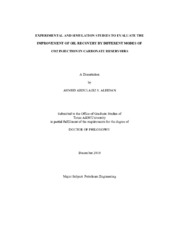| dc.description.abstract | Experimental and numerical simulation studies were conducted to investigate the improvement of light oil recovery in carbonate cores during CO2 injection. The main steps in the study are as follows. First, the minimum miscibility pressure of 31ºAPI west Texas oil and CO2 was measured using the slimtube (miscibility) apparatus. Second, miscible CO2 coreflood experiments were carried out on different modes of injection such as CGI, WF, WAG, and SWAG. Each injection mode was conducted on unfractured and fractured cores. Fractured cores included two types of fracture systems creating two shape models on the core. Also, runs were made with different salinity levels for the injected water, 0 ppm, 60,000 ppm, and 200,000 ppm. Finally, based on the experimental results, a 2-D numerical simulation model was constructed and validated. The simulation model was then extended to conduct sensitivity studies on different parameters such as permeability variations in the core, WAG ratio and slug size, and SWAG ratio.
The results of this study indicate that injecting water with CO2 either simultaneously or in alternating cycles increases the oil recovery by at least 10 percent and reduces the CO2 requirements by 50 percent. The salinity of the injected water has shown a detrimental effect on oil recovery only during WAG and SWAG injections. Lowering injected water salinity, which increases the CO2 solubility in water, increases oil recovery by up to 18 percent. Unfractured cores resulted in higher recovery than all fractured ones. CGI in fractured cores resulted in very poor recovery but WAG and SWAG injections improved the oil recovery by at least 25 percent over CGI. This is because of the better conformance provided by the injected water, which decreased CO2 cycling through the fracture.
CO2 injection in layered permeability arrangements showed significant decrease in oil recovery (up to 40 percent) compared to the homogenous case. For all injection modes during the layered permeability arrangements, the best oil recovery was obtained when the flow barrier is in the middle of the core. When the permeability was arranged in sequence, each injection mode showed different preference to the permeability arrangements. The WAG ratio study in the homogenous case showed that a 1:2 ratio had the highest oil recovery, but the optimum ratio was 1:1 based on the amount of injected CO2. In contrast, layered permeability arrangements showed different WAG ratio preference depending on the location of the flow barrier. | en |


